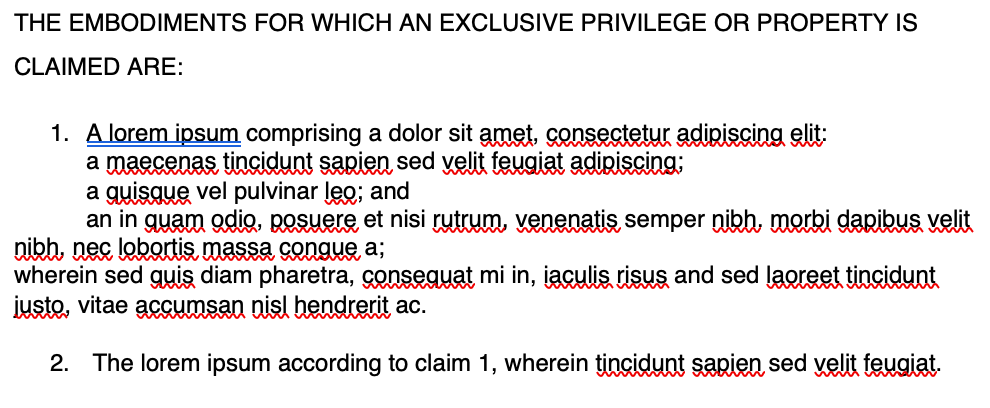Why should I use a Patent Agent?

As an inventor, you can certainly draft and file your own patent application. Also, if you want, you can receive and respond to the Patent Office’s Examiner’s Reports (often called an Office Action) yourself. So why do you need a patent agent?
The short answer is you don’t. However, to paraphrase Abraham Lincoln, “The inventor who acts as his or her own patent agent has a fool for a client.”
Why? Well, the patent drafting and prosecution process poses a number of challenges that complicate the process. New challenges crop up all of the time.
Use a patent agent for: Claim drafting

The claims in this case are actually in Latin. Most of the time, it only seems that way!
Claim drafting poses the biggest obstacle in the patent drafting process.
Basic rules of patent claims
First, you need to obey the basic rules of patent claims:
- Each claim consists of a grammatically-correct (but usually, run-on), sentence in English (in Canada, or French);
- Remember that many terms have multiple meanings;
- Refer to terminology consistently throughout all the claims (and in the rest of the patent); use the indefinite article (“a”, “an”) the first time and the definite article (“the”) every other time; remember that the patent office may treat synonyms and different word forms as different concepts;
- If you use the same term to describe two different things, add defined modifiers such as “first”, “second” etc., or names such as “inner”, “outer”; avoid relative modifiers (“larger”); use the modifiers consistently and repeatedly;
- Don’t reference anything outside the patent; within the patent, don’t reference the drawings, page, paragraph or line numbers; in most jurisdictions avoid referencing reference numerals of features in the drawings;
- Avoid bulleted, numbered (or lettered) lists;
- Stay away from alternatives, especially the word “or”; and
- Only use positive, not negative concepts, including the absence of something.
A registered patent agent frequently works within this complicated framework of rules to draft claims that describe the invention.
Claim the invention broadly
Then, you need to claim your invention broadly. Most inventors (and indeed many patent agent trainees) tend to draft their claims too narrowly, that is, they add too many limitations on what they say their invention is. The patent examiner is not going to object. The examiner may even allow the application, often on the first try, since you are requesting a very narrow monopoly. He or she is only too glad to grant a patent with overly narrow patent claims. You just made the examiner’s job very easy!

How would you describe the invention of the simple paper clip?
A simple example. Consider the lowly paper clip. Assume you just came up with this invention. How would you describe the invention in claim language?
Ready, set, go! (Really. The best way to figure this out is to try to write out a claim using the rules set out above. We will wait for you to finish. Also, time yourself and figure out how long it took you to draft a single claim.)
What did you come up with? In most cases, your claim probably mentioned one or more of :
- metal
- wire
- loop (often small and large – these are relative terms and violate one of the rules!)
- flat
Metal, Wire, Loop?
Now think about those features listed above that you have in your (written or imaginary) claim. Have you ever seen a plastic paper clip? Those aren’t metal and usually aren’t in a wire. What about “loop”? Have you ever seen paper clips like these?

Where is the metal? wire? loop?
Flat?
Do all paper clips have to be flat? What about the oldie but goodie below?

This paper clip isn’t even flat!
All of the features listed (metal, wire, loop, flat) are not necessary to the broad inventive concept (discussed below). If you include any of them, you are unnecessarily narrowing the scope of your patent.
A registered patent agent can help you eliminate features of your invention that are not necessary to the broad inventive concept.
Claim the invention functionally
A better approach is to claim the invention, not by what it is or what it looks like, but by how the invention functions. If you claim functions, instead of structure or features, it will cover any invention that performs the function, whether or not it has the same structure or features that you came up with. This will help provide you with a broader claim.
Of course, the patent office is hip to this. Many jurisdictions have (more!) rules that try to force you to provide at least some structure in your claim. For example, at a minimum, the patent office forbids claiming a result. The claim must at least identify how you obtain the result. But there is a wide gulf between result-only claims and overly narrow claims that put in a lot of unnecessary structure. This is one important area, where a registered patent agent can help you.
(By the way, click here if you want to see a sample claim that covers all three types of paper clips shown. And this isn’t even a very good claim, but it illustrates the concept of claiming functionally, and thus relatively broadly! If you can, identify a type of paper clip that this claim doesn’t cover. If you do, e-mail us and let us know. We will try respond with a revised claim!)
Good registered patent agents think of things functionally, as opposed to structurally, and describe concepts in functional language, while still obeying the rules set up by the patent office.
Claim the invention!
When working with inventors over the years, we have noticed that very often, the idea that the inventor has, of what the invention consists, is fairly different from what we understand the invention is. This is, we think, a natural result of the inventive process. The inventor identifies a problem and comes up with a solution. As long as the solution solves the problem, all investigation tends to stop and the inventor thinks of the solution as the invention.
Because, as a patent agent, we are looking at the function, not necessarily the structure, of the solution, often we can see (or can ask the inventor, to get a sense of), not only how the solution solves the inventor’s particular problem but how the solution could solve other, related (or even unrelated) problems. This allows us to do two things to broaden the claim. First, we can get rid of features that only relate to the particular problem that the inventor was trying to solve. Second, we can describe the invention in terms of generalities, that include not only the problem identified by the inventor, but the other problems that the solution solves.
A skilled and experienced patent agent can work with you to properly identify your inventive concept, which will get you a claim describing an invention that may be broader than the invention you thought you had come up with.
Use a patent agent for: Exam prep
The patent agent can then work with you to prepare a set of claims, gradually adding features or limitations to the previous claim(s), until there is a claim that covers the particular solution that you came up with and which solves the problem that you were trying to deal with.
You can use this further set of claims during the examination process. If the examiner raises prior art, we can get around the examiner’s concern by importing a feature from a lower, or dependent claim that distinguishes the invention from the prior art, into the main patent claim.
The problem of patent “bins”
In many technical areas, including the high technology and chemical / pharmaceutical fields, the governments of different countries and/or the patent courts have developed specific rules forbidding some claims on the basis of lack of patentable subject matter. In many cases, an experienced patent agent can help you circumvent these rules by small changes to the form and structure of the claims.
Save your money
Believe it or not, an experienced patent agent can even save you money through claims drafting. Many jurisdictions, including the US and the EP, assess penalties if you have too many claims. Some, like the US, have fancy counting rules so that, even if you think you have less than the threshold number of claims, you still have to pay expensive excess claims fees.
Use a patent agent for: Patent Descriptions
There are challenges in the drafting of the patent description as well, although these are less critical. The most important rule is that you can’t add information after the initial patent filing. An experienced patent agent can help you extract and set out further details in the description during the drafting process, to make the examination process later much easier.
Other rules include the enablement and best mode requirements. Some jurisdictions have rules to ensure there is support in the figures and/or the description for specific types of claims, such as method claims. If you don’t, your patent may not be valid.
Use a patent agent: Meeting deadlines
There are lots of deadlines during the examination process. You need to meet all of these deadlines. A patent agent will record them and remind you before they come up to make sure that you won’t miss them. You may have to choose between several actions, each with different deadlines, or a series of steps at different stages in the examination process. The Examiner will not normally explain these options at all, or in a way you understand. If you don’t choose correctly, however, you may lose patent rights; ignorance, or lack of experience, does not excuse this.
It’s what you say and how you say it
Finally, you must take be careful, especially in some jurisdictions, how you respond to the Examiner’s concerns. The words you use in response to an Office Action, may limit the protection your invention might otherwise have after it eventually issues.
Use a patent agent for: Focusing on innovation
With all of this in mind, we believe that you should concentrate on developing your technology and growing your business, without worrying about obeying the many confusing patent rules.
Broad patent and legal experience of DSL Patents Inc.

We are a registered patent firm based in the GTA (Markham-Stouffville region). However, we operate a location-independent practice that supports Canadian inventors and start-ups from coast to coast.
Drafting experience
We have 20+ years’ experience drafting and prosecuting Canadian, US and international patent applications, on inventions including:
- high-tech (communications, electronics, computer and optical)
- medical
- FinTech
- automotive
- oil and gas
- agriculture
- building technologies
- simple and complex mechanical devices,
- gaming
- sports
- consumer and
- recreational inventions.
Litigation experience
We also have general, IP and patent litigation experience. Our CEO Dennis Leung (his LinkedIn profile is here), is a (non-practising) lawyer and registered patent agent. While a lawyer, Dennis worked at many leading Canadian full-service law firms (McCarthy Tetrault, Ogilvy Renault (Norton Rose Fulbright)) and IP boutiques (Smart & Biggar, Ridout & Maybee, Shapiro Cohen (Aventum IP)).
Dennis was counsel before the Supreme Court of Canada in the leading case on patent claim construction (Whirlpool v. Camco).
Licensing experience
Dennis worked in-house with a leading reverse engineering firm. He set out strategies, reviewed contracts and supported its clients’ international patent licensing programs.
Teaching experience
Dennis taught Patent Law at Queen’s University’s Faculty of Law for several years. He wrote the Canadian chapter in a leading text on Global Patent Claim Construction. Finally, he trained many of today’s current registered patent agents on each of the topics of the patent agent exams.
For further information
If you want to find out more about the patent process and how using a patent agent from DSL Patents Inc. can free you up to focus on your innovations, please contact us for a free consultation at your convenience:

+1.613.668.2746 (phone or text)
+1.866.599.6608 (fax)
www.dslpatents.com/Contact
